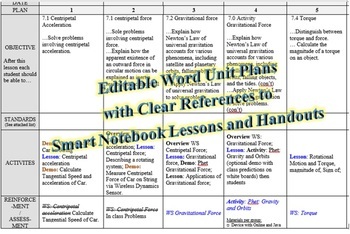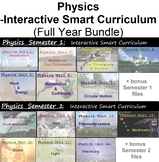Physics Semester 1 -Interactive Smart Curriculum (Bundle)
- Zip
Products in this Bundle (7)
showing 1-5 of 7 products
Bonus
Also included in
- This is a Whole Course Bundle of the Physics -Interactive Smart Curriculum. [It was only recently bundled into a full year, so see ratings & reviews on the existing Semester 1 and/or 2 downloads if looking for that information].OK. WHAT IS THIS CURRICULUM? WHAT IS IT LIKE TO TEACH THIS?ConsiderPrice $149.00Original Price $181.00Save $32.00
Description
AN INTRODUCTION. Consider some student feedback from this course:
- "I think that with all that had happened this year [Covid-19 year], this class did very well... I am going to ... become a physics teacher, I am very excited to share this knowledge with other people."
- "It has been a really fun and helpful year being a part of your class. Thank you"
- "I love all the labs (both virtually using java programs, and physically) that we did in class."
- "I really loved this course. It felt like a perfect continuation from Chemistry last year."
- "It was a well taught class and everything that was done helped me learn."
- "I learned a lot and Physics was my favorite class of the year. So thank you."
WHAT MAKES THIS CURRICULUM SPECIAL?
This course was designed by a professional licensed physics educator, and it is ready to be implemented by you -another professional educator who knows how to guide students to demonstrate the fulfillment of specific Lesson Objectives. I don't believe the teacher's role is to be a "dispenser of fill-in the blanks" but a guide who can get students to want to pursue scientific pursuits of their own. With clear and logical lessons, deliberate practice, step-by-step solutions, and real-world labs already planned, you can focus on what matters: displaying your own excitement and passion for learning while offering guidance and feedback for your students.
I chose to honestly list what is designed for: Juniors and Seniors taking a high school Physics class -a coherent, algebra-based, college-prep Physics course. Not a rerun of the content and methods used in freshmen Physical Science.
Care was taken in the planning stage such that, in addition to the routine review of student independent work, the scientific concepts and mathematical approaches naturally connect and build on each other in a planned and logical manner as the course progresses. In other words: The planning is mostly done, leaving you with the ability (privilege really) to expound, discuss, and explore the topics with students.
I don't charge anywhere near what others do for a full Physics course?! Yes. It is my sincere hope that I can provide you with a well-planned curriculum that will save you time and give you the ability to focus your energy where it is needed.
Buy with confidence after checking out
- View Preview icon above,
- This free sample lesson,
- An in-depth video Overview of the download,
- The entire introductory Unit 1 downloadable for free,
- and an offer to email me to freely preview and then "use as you see fit in your classroom" any other unit in the curriculum. (email given in video Overview)
- all with no obligation to follow through with a purchase. - The lessons here run on either the Free/Basic version of Notebook or the Full/Paid version.
WHAT IS THIS PRODUCT?
This Semester/Unit-bundle contains READY-TO-TEACH and EDITABLE Word Unit plans & Smart Notebook based Lessons and all the supporting materials you need to teach from beginning to end.
Designed to make use of an interactive screen/interface, this curriculum is ready for live-in-person learning and also adaptable for virtual learning. The key is having Notebook Software [see "what do I need" heading below] and some type of touch screen interface (whether a board in your classroom or a tablet or touch laptop at home). [Click here to learn how to get going at shifting your classroom to do synchronous distance learning and/or asynchronous distance learning, in little time, for free, with this curriculum or any other.]
"Physics Semester 1" is one of two semesters developed for a comprehensive and progressive Smart Curriculum for high school Physics. This Semester and the other in the full-year course function as an honors High School Physics course, which means the topic progression for Semester 1 prepares students for the first course in algebra-based college physics: Mechanics. See the products list below for a complete listing of Units within Semester 1. The lessons are well suited to general through honors-level high school physics and ready for differentiated instruction as determined by the instructor, up to AP Physics 1. Note: The course is not explicitly designed to prepare students for taking the AP Physics 1 exam, which when passed offers college credit, but to prepare students for successful immersion in general college physics (Nevertheless I have had students take it upon themselves to sign up for the Physics AP1 exam based on this course). Concurrent enrollment in Algebra II or higher is recommended.
[Instructors attempting to adapt this curriculum as a foundation for AP Physics 1 : I would recommend including all of this Semester 1 product but only select units from my Semester 2 (the units of Wave Mechanics, Sound, and Electricity are a measured part of the AP Physics 1 exam). Extra exam-specific prep would need to be added in the omitted units places as well as throughout the rest of the course (my Semester 2 units on Fluids, Heat, Thermodynamics, and Light are not part of the AP Physics 1 exam)].
WHAT WILL I GET WITH THIS PRODUCT?:
Click here for a Video Overview of the download. This product is a bundle of zipped folders that include all of the digital material needed to teach the first semester (Mechanics) in a high school physics course over 81-90 days.
- Suggested and editable Unit plans are included, with two pacing options when appropriate. Also, directions for importing Planbook Plans are included.
- Over 70 Editable "Ready to Teach" notebook files are included. The lessons here run on either the Free/Basic version of Notebook or the Full/Paid version. Lessons follow the Madeline Hunter approach with the average lesson consisting of about 20 minutes of "tell me" and/or "show me" and 20 minutes of "Involve me."
- Summative Unit assessments that require critical thinking through application, synthesis and evaluation of the material are provided.
- The digital version of all student handouts, worksheets, and tests is included.
- Step-by-Step Solutions for all worksheets and simulation labs are included. Directions for teachers to obtain Test solutions from a verified school email are also provided.
- "Filled-in" static notes for Lessons and Guided practice are included. These enhance the clarity, provide additional notes and suggestions while teaching, and create a more thorough product, especially intended for teachers less familiar with Physics. Update 2020: The provided filled-in notes also work great for sharing with students when going virtual.
- A semester exam is included. Also, directions for an optional full review week, based on links to select free material from the physics classroom is included.
WHAT DO I NEED?
The bundled Units and each of the lessons within the units are self-sufficient, with built-in interactivity and clearly named files (supporting files are name-tagged by the lesson in which they are first used). They are designed, by necessity, to be ready for the experienced teacher to teach and reteach after only a brief pre-class viewing. Filled-in portions for the lesson and guided practice are also included as a quick reference, especially for those who are newer to teaching physics.
SMART NOTEBOOOK SOFTWARE IS REQUIRED. To see if you have Smart notebook software, simply check out this free sample lesson that illustrates this curriculum and how I teach. If the sample lesson doesn't work, then before you make any purchases you should ask your school's tech support to have the software installed. The software can be downloaded directly by schools or individuals. The lessons here run on either the Free/Basic version of Notebook or the Full/Paid version. Regardless of whether you adopt this curriculum or not: I would not recommend trying to teach this (or any algebra-based physics) without interactive Software similar to Smart Notebook.
Once you have Notebook software on your primary classroom computer (Windows or Mac) it will work on whatever primary classroom display you have hooked up to that computer. Some type of interactive interface (interactive-whiteboard/interactive-projector/touchscreen/touch-TV/tablet/etc) is also very highly recommended in order to effectively deliver the lessons. Just be sure you have some type of touch interface because it can be difficult if your only interface is a mouse. I have taught it quite comfortably with: a SmartBoard, Epson Interactive Projector, and a generic touch-screen monitor. I also found myself teaching portions with just a mouse when at home doing Distance Learning. Its really only a matter of personal preference and availability.
Many lessons require internet access for the instructor and students and are optimized for a one-to-one computer environment. These independent activities can also be adapted to a whole-class guided activity if your computer resources are limited to a single teacher computer.
Along with the standard equipment one would expect a high school physics classroom to be equipped with (rulers, carts, clay, springs, and so on) many of the labs utilize student computers for video analysis. Although the software for video analysis can be obtained through multiple sources and apps, including at least one free downloadable version, the most learning-orientated, useful, intuitive, and easiest to teach from is Vernier's Logger Pro. You can download a free demo (Windows or Mac) or try Vernier's Video Analysis app (works on all platforms). I would highly recommend familiarizing yourself with one of these and making them available on student devices. Once purchased, Vernier offers a very generous site license in which you "can install on any device, including students' computers" policy. If you want something free, and actually more powerful, but less intuitive, I would recommend Tracker (Windows or Mac, v.5.0 or higher runs "right out of the box" now, no extra installations like java are needed). I have employed Tracker and Tracker apps with great success when unable to install LoggerPro on student devices. Download Tracker (or other) and check out the help tutorials. Other options are available but are less helpful at teaching/learning the real-world-to-graph &equation relationships. Kinova might be considered more user friendly and less technical than Tracker, but only instantaneous velocity is given for a track, making it difficult to analyze slopes or perform linear regressions (and hence examine motion, speed, velocity changes). Logger Pro is the top choice, especially for instructor demos. But if you aren't willing to pay the nominal software license or you intend on students using something else (Tracker or other) then I would recommend that, during early demonstrations, you stick with what the students will be using. In this way, you can teach it to them and you can better learn how it works for when it comes time to assist them during lab work .
I have recently compiled a helpful set of Answers to Frequently Asked Questions, so please check out the end of the Preview for this product.
Enjoy!
OTHER PRODUCTS:
Other Complete Units in this full year, two semesters, course include:
Semester 1: <--(this is the product you are viewing)
Two Dimensional Motion and Vectors
Circular Motion and Gravitation
Semester 2: (this is sold separately)
Light: Reflection, Refraction, Interference, Diffraction.
For an additional discounted price and additional resources (such as semester exams, and supplements) please consider purchasing these Entire semesters or Entire Course products in my store:
Physics: Semester 1 -Interactive Smart Curriculum
Physics: Semester 2 -Interactive Smart Curriculum.
Physics: -Interactive Smart Curriculum (Whole Course Bundle)






